Ultraviolet light provisioning: Preferences from the broilers’ viewpoint
IF 2
2区 农林科学
Q1 AGRICULTURE, DAIRY & ANIMAL SCIENCE
引用次数: 0
Abstract
The light provisioning in barns can have a great impact on broiler health and welfare. In contrast to humans, broilers are able to see ultraviolet light, and it has been suggested that UV-A light provisioning can have beneficial effects on broilers. However, it is yet unclear what broilers’ preferences regarding UV-A light are. This study investigated preferences of in total 168 fast- (Ross 308; R) and slower-growing (Hubbard JA757; H) broilers, distributed across 14 pens, for two light conditions: UV-A light provided (UV) or no UV-A light provided (non-UV). These light conditions were provided in replicate pens with two separate compartments (one UV and one non-UV) that the birds could freely move between. From hatching until slaughter age, it was studied 1) where broilers chose to be, 2) what behaviours were performed in the two light conditions, and 3) how much feed was consumed in the two light conditions. Across the day (05.00–23.00 h), both breeds appeared to show a preference for the UV light condition in the first weeks of life but later in life no clear preferences were observed. In the evening (19.00–23.00 h), R birds did not show a clear preference, whereas H birds showed a preference for UV in the first four weeks and a preference for non-UV light in weeks 6–8. Regarding behaviour, more drinking behaviour was observed in the UV condition compared to the non-UV condition in both breeds and more foraging behaviour was observed in H birds in the non-UV light condition than H birds in UV or R birds in either light condition. Furthermore, higher average daily feed intakes were observed on the UV side than on the non-UV side, during the starter feed phase for both breeds and during the finisher feed phase for R birds. Overall, apart from the first weeks, no preference for – or avoidance of – the UV light was observed during the day, but there was a shift in preference from UV to non-UV light in the evening over time for H birds. Furthermore, there were few preferences related to behaviour, but there was an indication for a higher feed intake under UV light conditions. The results of this study emphasize the importance of offering varied light conditions to broilers, so the birds can select their preferred light condition at a given time.
紫外光供应:肉鸡的偏好
鸡舍内饲料供应不足对肉鸡的健康和福利有很大的影响。与人类不同的是,肉鸡能够看到紫外线,并且有人认为提供UV-A光对肉鸡有有益的影响。然而,目前还不清楚肉鸡对UV-A光的偏好是什么。本研究共调查了168种快速- (Ross 308;R)和生长较慢的(Hubbard JA757;H)肉鸡,分布在14个栏中,在两种光照条件下:提供UV- a光(UV)或没有UV- a光(非UV)。这些光照条件是在两个独立的隔间(一个紫外线和一个非紫外线)的复制围栏中提供的,鸟类可以自由地在其中移动。从孵化到屠宰年龄,研究了1)肉鸡选择在哪里,2)在两种光照条件下表现出什么行为,以及3)在两种光照条件下消耗了多少饲料。在一天中(05.00-23.00 h),两个品种似乎在生命的最初几周表现出对紫外线条件的偏好,但在生命的后期没有观察到明显的偏好。在夜间(19.00-23.00 h), R型鸟类没有表现出明显的偏好,而h型鸟类在前4周表现出对紫外线的偏好,在6-8周表现出对非紫外线的偏好。在行为方面,两个品种在紫外线条件下的饮水行为都比无紫外线条件下的多,而在无紫外线条件下,H型鸟的觅食行为比紫外线条件下的H型鸟或两种光照条件下的R型鸟的觅食行为都多。此外,在两个品种的起始饲料阶段和R鸟的育肥期,观察到紫外线侧的平均日采食量高于非紫外线侧。总的来说,除了头几周,没有观察到白天对紫外线的偏好或回避,但随着时间的推移,H鸟在晚上从紫外线到非紫外线的偏好发生了转变。此外,与行为有关的偏好很少,但有迹象表明在紫外线条件下采食量更高。这项研究的结果强调了为肉鸡提供不同光照条件的重要性,这样肉鸡就可以在给定的时间选择他们喜欢的光照条件。
本文章由计算机程序翻译,如有差异,请以英文原文为准。
求助全文
约1分钟内获得全文
求助全文
来源期刊

Applied Animal Behaviour Science
农林科学-行为科学
CiteScore
4.40
自引率
21.70%
发文量
191
审稿时长
18.1 weeks
期刊介绍:
This journal publishes relevant information on the behaviour of domesticated and utilized animals.
Topics covered include:
-Behaviour of farm, zoo and laboratory animals in relation to animal management and welfare
-Behaviour of companion animals in relation to behavioural problems, for example, in relation to the training of dogs for different purposes, in relation to behavioural problems
-Studies of the behaviour of wild animals when these studies are relevant from an applied perspective, for example in relation to wildlife management, pest management or nature conservation
-Methodological studies within relevant fields
The principal subjects are farm, companion and laboratory animals, including, of course, poultry. The journal also deals with the following animal subjects:
-Those involved in any farming system, e.g. deer, rabbits and fur-bearing animals
-Those in ANY form of confinement, e.g. zoos, safari parks and other forms of display
-Feral animals, and any animal species which impinge on farming operations, e.g. as causes of loss or damage
-Species used for hunting, recreation etc. may also be considered as acceptable subjects in some instances
-Laboratory animals, if the material relates to their behavioural requirements
 求助内容:
求助内容: 应助结果提醒方式:
应助结果提醒方式:


